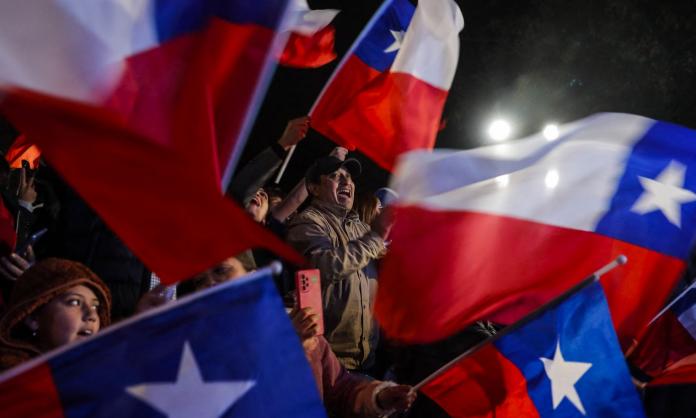The process of creating a more progressive Chilean constitution took another decisive step on 9 May. Unfortunately, it was a step further away from the demands of the 2019 rebellion, which pushed the conservative government to the brink of collapse and forced it to initiate the constituent process as a way out of the political crisis.
In elections to the Constitutional Council, a new body tasked with drafting a second constitutional text after the first was defeated in a referendum last year, the big winners were the far right. The list of José Antonio Kast, runner-up in the 2021 presidential election, gained the most votes. With 23 out of 51 seats, his bloc fell just short of a majority. Combined with the traditional conservative bloc, which won eleven seats, the right holds more than two-thirds of the Council seats.
The result was another major blow to the government of leftist former student leader Gabriel Boric, who was elected promising to enshrine the demands of the rebellion in a new constitution. This second constituent process was born of an agreement between Boric and right-wing congressional parties. Unlike in the first constituent process, when a convention was elected to write the text, this time the elected members will not be drafting a new constitution but rather approving, rejecting or amending a draft already written by an “Expert Committee” consisting of 21 legal professionals, a journalist, an economist and a sociologist.
The Committee, appointed by Congress, is to write the new text within the framework of twelve “constitutional bases”, a set of guiding principles agreed by legislators. They include amendments stating that Chile is “one and indivisible”—a clear rejection of the demand for a plurinational state in which indigenous communities have more autonomy. And where the first revised constitution abolished the highly undemocratic Senate and replaced it with a Chamber of Regions to decentralise power, one of the guiding principles enshrines the Senate.
So even before the draft text is handed to the Constitutional Council, which itself has minimal control over it, severe limitations have been imposed.
Only a few years ago, the working class was on the offensive, acting collectively through millions-strong protests and a general strike that paralysed the country and nearly toppled a billionaire president. The leaders of that movement rode a wave of discontent into the presidency and government. Now the movement itself is at its weakest point.
In the original constitutional convention, the right was unable to win even one-third of the seats. Now, it has a dominating majority of more than two-thirds. To make matters worse, the traditional conservative block since 2019 has been completely overtaken by a far-right bloc that embraces a far more anti-working-class and anti-immigrant platform.
How did Chile arrive at such a dire situation so quickly after one of the most inspiring mass movements in recent memory?
In part because the working class is led by the reformist leaders of the Broad Front and Communist Party, in alliance with the trade union bureaucracy. In every decisive moment, this leadership has sought compromise with the right and demobilised the street movement. Boric himself was a key player in the creation of the Agreement for Peace and a New Constitution, the original congressional agreement that saved the right-wing government in 2019 and offered it an institutional exit to the rebellion.
The latest agreement to draft a second text is a continuation of this failed strategy.
The 2019 rebellion showed workers and oppressed people that through collective action and struggle they could push back against the neoliberal offensive of the last 40 years, and their expectations of what would come out of that struggle were justifiably raised. But now, for millions of Chileans, the consciousness-raising experience of participation in a mass movement has been replaced by demoralisation and disillusionment as it becomes clearer that the political leaders of the movement are committed not to advancing it but to holding it back.
Even in government, Boric has shown no desire to meet the demands of the movement. He has replaced his more leftist ministers with conservative ones, and on key issues he offers nothing of any genuine progressive content. Take, for example, the nationalisation of the mining sector, a key demand of the movement. His proposal for nationalising Chile’s lithium industry has been extremely conservative, stipulating that no nationalisation will occur until all current contracts expire, which for the two major producers is in 2030 and 2043 respectively. One of the companies responded to the nationalisation plan by saying it would have “no material impact on our business”.
Boric upholds the right’s law and order agenda, refuses to free all political prisoners from 2019, and offers no real solutions to the millions of Chileans struggling to make ends meet in the cost-of-living crisis. This is a key reason why there was such a high amount of null and blank votes and abstentions in the election—around one-third in total.
The rightward trajectory of Boric will probably continue. At the same time, the political situation increasingly plays into the hands of the right, which, after the defeat of the first referendum, has positioned itself as more in touch with the people than this supposedly radical left government of former student leaders.
With the streets empty of protesters, Boric and the ruling class feel no pressure to meet any of the progressive demands of recent years. Meanwhile, the far right continues to grow. If current trends continue, it will be in a strong position for the 2025 presidential election. The reformist leaders would prefer this scenario to a return to mass struggle, which they and the union bureaucracy will continue to hold back.
The only real solution for the Chilean working class is to re-ignite the movement of 2019 and retake the offensive.










